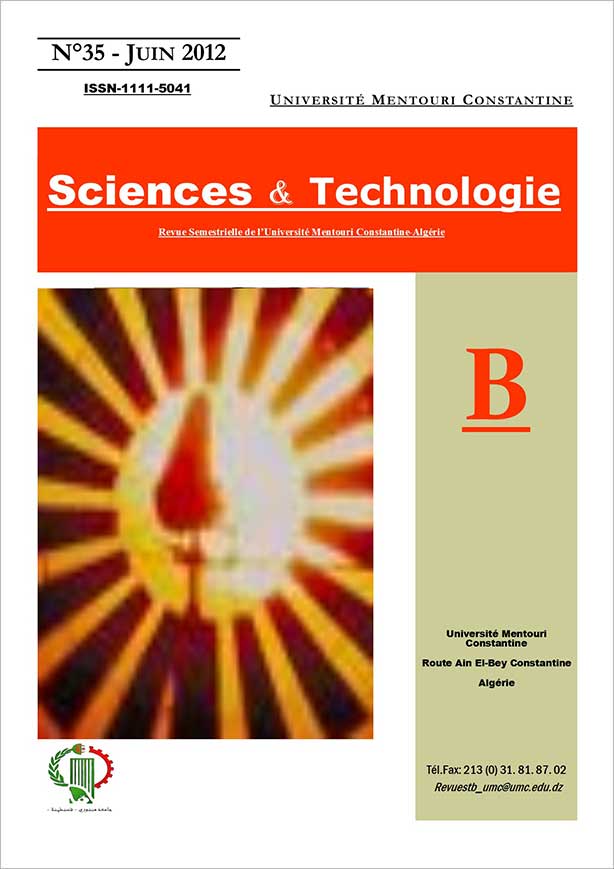ARMATURE TRANSVERSALE POUR NOYAUX DE PORTIQUES AUTOSTABLES « CONTROLE DE L’ENDOMMAGEMENT RESULTANT »
Mots-clés :
Nœud poteau - poutre, noyau, béton armé, distorsion, endommagement, performance, résistanceRésumé
Les portiques en béton armé peuvent exhiber un comportement ductile lors d’un séisme sévère si l’instabilité et la rupture de leurs éléments structurels sont évitées. Pour que les éléments concourants (poteaux, poutres) puissent développer leur capacité de résistance, les ruptures de type fragile sont d’emblée évitées au niveau de la conception initiale. La dégradation de la rigidité du noyau du nœud est réduite en minimisant l’ouverture des fissures au sein de ce dernier afin de maintenir son intégrité structurelle. Le principal objectif de ce travail est de proposer une expression simple d’utilisation donnant l’armature transversale requise pour le contrôle du niveau d’endommagement résultant de la distorsion angulaire du noyau de nœud afin de le maintenir dans le domaine élastique. Cette expression s’accorde avec le dimensionnement en performances et s’accommode avec la variation de l’élancement du noyau, les caractéristiques des matériaux et du nombre de lits à disposer latéralement. Une comparaison avec des expressions analytiques trouvées dans la littérature pour un nœud externe a été aussi établie.
Références
SANZS (Standard Association of New Zealand) (1982), (a) Code of Practice for the Design of Concrete Structures (NZS 3101-Part 1: 1982; (b) Commentary on Code of Practice for the Design of Concrete Structures (NZS 3101-Part 2: 1982). Wellington.
ACI-ASCE Committee 352(1985) Recommendations for design of beam-column joints in monolithic reinforced concrete structures (ACI 352 R-85) Journal of the ACI, 83(3), pp. 266-283.
CEN Techn. Commm. 250/SC2 (EC8 1995) Eurocode 8 : Earthquake – Resistant Design of Structures – Part I : General Rules and Rules for Buildings (ENV 1998-1-1), CEN, Berlin.
Penelis, G.G., Kappos, A.J., (1997) 'Earthquake-Resistant Concrete Structures' Published by E&FN Spon.
Park, R., Paulay, T., (1975) ‘Reinforced Concrete Structures’, J.Wiley, New-York.
Fintel, M.,( 1985) ‘Handbook of Concrete Engineering’, Second edition, Van Nostrand.
Park, R., (1992) ‘Capacity Design of Ductile RC Building Structures for Earthquake Resistance’ The Structural Engineer, Vol. 70, N°16, pp. 279-289.
Cheung, P.C., Paulay, T., Park, R.,(1993) ‘Behaviour of Beam-Column Joints in Seismically-Loaded R.C Frames’. The Structural Engineer, Vol. 71, N°8, pp. 129-138.
Bakir, P.G., Bodoruglu, H.M., (2002) ‘Predicting the failure modes of monotonically loaded RC exterior beam-column joints’. Engineering Structures, Vol. 14, N°3, pp. 307-330.
Kim, J.H., Mander, J.B., (2000) ‘Seismic detailing of reinforced concrete beam-column connections’ Structural Engineering & Mechanics, Vol.10 N°6, pp. 589-601.
Shiohara, H.,(2000) 'Effects of Interaction Between Joint Shear and Bond Strength on the Elastic-Plastic Behaviour of R/C Beam-Column Joints'. Second US-Japan Workshop on Performance-Based Earthquake Methodology for Reinforced Concrete Building Structures; Sapporo Hokkaido Japan. PEER 2000/10, pp. 401-414.
Teroaka, M., Fujii, S.,(2000) 'Seismic Evaluation of R/C Beam-Column Joints' Second US-Japan Workshop on Performance-Based Earthquake Methodology for Reinforced Concrete Building Structures; Sapporo Hokkaido Japan. PEER 2000/10, pp. 379-390.
Hwang, S.J, Lee, H.J., (2002) 'Design and Retrofitting Strategy of RC Beam-Column Joints’. Recent Advances in Seismic Design of RC Buildings in Taiwan
Vecchio, F.J, Collins, M.P, (1986) ‘The modified compression field theory for reinforced concrete elements subjected to shear’, ACI Journal, 83(2), pp. 219-231.
Kitayama, K., Tajima, Y., Okuda, M., Kishida, S.,(2000) 'Influences of Beam and Column Bar Bond on Failure Mechanism in Reinforced Concrete Interior Beam-Column Joints' Second US-Japan Workshop on Performance-Based Earthquake Methodology for Reinforced Concrete Building Structures; Sapporo Hokkaido Japan. PEER 2000/10, pp.357-364.
Heggar, J., Sherif, A. & Roeser, W., (2003) ‘Non seismic design beam column joints’ ACI Structural Journal, Vol 100 N°5, pp. 654-664.
Bakir, P.G., Bodoruglu, H.M., (2002) ‘A new design equation for predicting the joint shear strength of monotonically loaded exterior beam-column joints’ Engineering Structures, Vol. 24, pp. 1105-1117.
Téléchargements
Publié-e
Comment citer
Numéro
Rubrique
Licence
Les auteurs publiant dans cette revue acceptent les termes suivants :- Les auteurs détiennent le droit d'auteurs et accordent à la revue
le droit de première publication, avec l’ouvrage disponible simultanément [SPÉCIFIER LA PÉRIODE DE TEMPS] après publication, sous la licence Licence d’attribution Creative Commons qui permet à d'autres de partager l'ouvrage en en reconnaissant la paternité et la publication initiale dans cette revue. - Les auteurs peuvent conclure des ententes contractuelles additionnelles et séparées pour la diffusion non exclusive de la version imprimée de l'ouvrage par la revue (par ex., le dépôt institutionnel ou la publication dans un livre), accompagné d'une mention reconnaissant sa publication initiale dans cette revue.
- Les auteurs ont le droit et sont encouragés à publier leur ouvrage en ligne (par ex., dans un dépôt institutionnel ou sur le site Web d'une institution) avant et pendant le processus de soumission, car cela peut mener à des échanges fructueux ainsi qu'à un nombre plus important, plus rapidement, de références à l’ouvrage publié (Consulter The Effect of Open Access).

